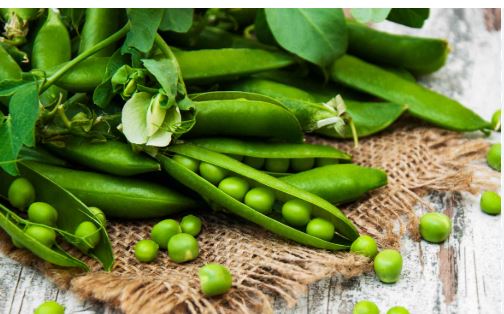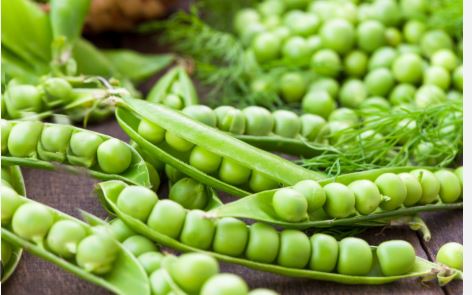
Peas (Pisum sativum) belong to the Fabaceae family, or legume family, alongside beans and lentils. They’re annual herbaceous plants in the genus Pisum, with P. sativum encompassing garden, snow, and snap peas. As dicots, they produce seeds in pods, with varieties differing in pod edibility. Note: Field peas like black-eyed peas (Vigna unguiculata) are a related but distinct genus.
Originating in the Near East around 10,000 BCE, peas were among the first domesticated crops, cultivated in the Fertile Crescent. They spread to Europe and Asia by 4,000 BCE, becoming a staple in medieval diets (e.g., pease porridge). Introduced to the Americas post-Columbus, modern breeding in the 19th-20th centuries (e.g., Mendel’s experiments) refined varieties for flavor and yield.
Peas vary: garden peas are round, green, and sweet in inedible pods; snow peas have flat, edible pods with tiny seeds; snap peas offer plump, edible pods with juicy peas. Fresh peas are tender and sweet, while dried ones (e.g., marrowfat) are starchy and earthy. Size ranges from 2-5 inch pods, with colors from green to purple.
Peas are cool-season crops, thriving in spring and early summer (March-June) in temperate regions; fall crops occur in milder climates. Harvest peaks in May-June in the Northern Hemisphere, with fresh peas available briefly and frozen/dried forms year-round. Major producers like China, India, and the U.S. ensure global supply.
Peas are nutrient-rich: 100 g fresh provides 81 kcal, 5 g protein, 7 g fiber, and vitamins C (40 mg) and K. They’re high in antioxidants (e.g., lutein) and minerals like iron and potassium. Low in fat and glycemic index, they support digestion, heart health, and blood sugar control; dried peas offer denser carbs.

Varieties of Peas
Lincoln Peas
- Description/Characteristics: Medium-sized, round, bright green peas in 3-4 inch inedible pods; sweet and tender with a smooth texture; vines grow 2-3 feet tall.
- Distribution: Originated in the U.S. (1908); widely grown in North America, Europe, and temperate regions of Asia; popular in home gardens.
- Culinary Uses: Shelled and eaten fresh, boiled, or steamed as a side dish; great in soups, risottos, or frozen for year-round use.
Sugar Snap Peas
- Description/Characteristics: Plump, edible pods, 2-3 inches long; bright green with juicy, sweet peas inside; crisp and crunchy; vines reach 5-6 feet.
- Distribution: A U.S. hybrid (1970s); grown globally, especially in the U.S., China, and Europe; a commercial favorite.
- Culinary Uses: Eaten raw in salads, stir-fried, or lightly steamed; a popular snack or appetizer due to their sweetness.
Oregon Sugar Pod II (Snow Peas)
- Description/Characteristics: Flat, edible pods, 4-5 inches long; pale green with tiny, undeveloped peas; tender and mildly sweet; bushy plants 2-3 feet tall.
- Distribution: Bred in Oregon, U.S.; widely cultivated in North America, East Asia, and Europe; disease-resistant.
- Culinary Uses: Stir-fried in Asian dishes, sautéed with butter, or added raw to salads for crunch.
Wando Peas
- Description/Characteristics: Medium, round peas in 3-inch inedible pods; dark green, sweet, and firm; heat-tolerant; plants grow 2-3 feet.
- Distribution: U.S.-developed; common in North America, southern Europe, and warmer climates; adaptable to late spring planting.
- Culinary Uses: Shelled for fresh eating, canning, or freezing; used in casseroles, stews, and vegetable medleys.
Mammoth Melting Sugar (Snow Peas)
- Description/Characteristics: Large, flat, edible pods, 4-5 inches; light green, succulent, and very sweet; vines grow 5-6 feet, needing support.
- Distribution: Originated in Europe; grown in the U.S., China, and East Asia; prized for heavy yields.
- Culinary Uses: Eaten whole in stir-fries, steamed as a side, or blanched for salads; popular in Asian cuisine.
Little Marvel Peas
- Description/Characteristics: Small, round, bright green peas in 3-inch inedible pods; sweet and tender; compact bush plants, 18-24 inches tall.
- Distribution: U.S.-bred (early 20th century); popular in North America, the UK, and temperate zones globally.
- Culinary Uses: Shelled for fresh use, mashed into spreads, or added to soups and pastas; ideal for small gardens.
Black-Eyed Peas (Vigna unguiculata)
- Description/Characteristics: Small, beige peas with a black “eye”; earthy flavor; grown in 6-8 inch pods; bush or vining plants.
- Distribution: Originated in West Africa; major crop in the U.S. South, India, and Africa; thrives in warm climates.
- Culinary Uses: Cooked in stews (e.g., Hoppin’ John), soups, or salads; dried or fresh, a Southern staple.
Tall Telephone (Alderman) Peas
- Description/Characteristics: Large, plump, green peas in 4-5 inch inedible pods; very sweet; vines climb 5-6 feet.
- Distribution: UK origin (late 19th century); grown in Europe, North America, and Australia; a heritage variety.
- Culinary Uses: Shelled for fresh eating, steamed, or pureed into soups; excellent in traditional English dishes.
Purple Podded Peas
- Description/Characteristics: Vibrant purple, inedible pods, 3-4 inches; green peas inside are sweet and tender; vines 4-5 feet tall.
- Distribution: European heirloom; grown in the UK, U.S., and parts of Asia; ornamental and edible.
- Culinary Uses: Shelled peas used in salads, risottos, or lightly cooked sides; pods add visual appeal to gardens.
Crowder Peas (Vigna unguiculata)
- Description/Characteristics: Medium, creamy peas packed tightly in 6-8 inch pods; nutty and hearty; bush plants 1-2 feet tall.
- Distribution: Southern U.S. origin; common in the U.S. South, Africa, and India; warm-season crop.
- Culinary Uses: Boiled with ham, served as a side, or mixed into rice dishes; fresh or dried for robust flavor.
Dwarf Grey Sugar (Snow Peas)
- Description/Characteristics: Small, flat, edible pods, 2-3 inches; light green, sweet, and tender; dwarf plants 2-3 feet.
- Distribution: Old U.S. heirloom; grown in North America, Europe, and Asia; valued for early harvest.
- Culinary Uses: Eaten whole raw, steamed, or stir-fried; adds delicate sweetness to light dishes.
Marrowfat Peas
- Description/Characteristics: Large, starchy peas from mature, inedible pods; green when fresh, dull when dried; robust texture.
- Distribution: UK specialty; grown in the UK, Canada, and northern Europe; a traditional field pea.
- Culinary Uses: Dried and rehydrated for mushy peas (with fish and chips), soups, or pease pudding; a British classic.
Blue Pod Capucijner Peas
- Description/Characteristics: Striking blue-purple inedible pods, 3-4 inches; round, green peas inside are sweet and tender; vines grow 4-5 feet.
- Distribution: Dutch heirloom (16th century); grown in Europe (Netherlands, UK), U.S., and Canada; ornamental and edible.
- Culinary Uses: Shelled peas used fresh in salads, steamed as a side, or added to soups for sweetness.
Cascadia Snap Peas
- Description/Characteristics: Medium, plump, edible pods, 3 inches; bright green with sweet, juicy peas; bush plants 2-3 feet tall; disease-resistant.
- Distribution: Bred in Oregon, U.S.; popular in North America, Europe, and temperate Asia; a modern favorite.
- Culinary Uses: Eaten raw as a snack, stir-fried, or blanched for dips; versatile in fresh dishes.
Golden Sweet Peas (Snow Peas)
- Description/Characteristics: Flat, edible pods, 2-3 inches; golden-yellow with tiny peas; sweet and crisp; vines reach 5-6 feet.
- Distribution: Indian origin; grown in India, the UK, U.S., and parts of Asia; rare and visually striking.
- Culinary Uses: Sautéed in butter, added to stir-fries, or used raw in colorful salads.
Hurst Green Shaft Peas
- Description/Characteristics: Medium, round peas in 4-inch inedible pods; dark green, very sweet, and tender; plants 2-3 feet tall; high yield.
- Distribution: UK-bred (1970s); common in the UK, Europe, North America, and Australia; award-winning variety.
- Culinary Uses: Shelled for fresh eating, frozen for storage, or cooked in risottos and casseroles.
Field Peas (Vigna unguiculata)
- Description/Characteristics: Small, beige to brown peas in 6-8 inch pods; earthy, nutty flavor; bush or vining plants; drought-tolerant.
- Distribution: Originated in Africa; grown in the U.S. South, West Africa, and India; a staple crop.
- Culinary Uses: Boiled with spices, used in stews, or served with rice; dried for hearty dishes.
Maestro Peas
- Description/Characteristics: Small to medium, round peas in 3-4 inch inedible pods; bright green, sweet, and succulent; bush plants 2 feet tall.
- Distribution: U.S.-developed; widely grown in North America, Europe, and temperate zones globally; reliable producer.
- Culinary Uses: Shelled for fresh use, steamed as a side, or pureed into soups and dips.
Super Sugar Snap Peas
- Description/Characteristics: Thick, edible pods, 3-4 inches; dark green with plump, sweet peas; vines grow 5-6 feet; improved Sugar Snap strain.
- Distribution: U.S. hybrid; cultivated in the U.S., China, Europe, and Australia; a commercial hit.
- Culinary Uses: Eaten raw, roasted, or stir-fried; popular in snacks and vegetable platters.
Desiree Dwarf Peas
- Description/Characteristics: Purple inedible pods, 3 inches; green peas inside are sweet and juicy; dwarf plants 18-24 inches; eye-catching.
- Distribution: European origin; grown in the UK, U.S., and Australia; both decorative and productive.
- Culinary Uses: Shelled peas used in fresh dishes, steamed, or added to pasta for flavor.
Pink-Eyed Purple Hull Peas (Vigna unguiculata)
- Description/Characteristics: Medium, creamy peas with a pink “eye” in 6-7 inch pods; rich, earthy taste; bush plants 2-3 feet.
- Distribution: Southern U.S. heirloom; common in the U.S. South, Africa, and parts of Asia; warm-season crop.
- Culinary Uses: Cooked with bacon or ham, served as a side, or mixed into cornbread recipes.
Kelvedon Wonder Peas
- Description/Characteristics: Small, round peas in 3-inch inedible pods; bright green, sweet, and tender; compact plants 18-24 inches.
- Distribution: UK-bred (1920s); grown in the UK, Europe, North America, and New Zealand; early maturing.
- Culinary Uses: Shelled for fresh eating, frozen, or used in classic pea soups and stews.
Snowbird Peas (Snow Peas)
- Description/Characteristics: Small, flat, edible pods, 2-3 inches; pale green with a delicate sweetness; dwarf plants 18 inches; quick-growing.
- Distribution: U.S.-developed; grown in North America, East Asia, and Europe; ideal for short seasons.
- Culinary Uses: Stir-fried with garlic, added to noodle dishes, or eaten raw in light salads.
Tom Thumb Peas
- Description/Characteristics: Tiny, round peas in 2-3 inch inedible pods; green, sweet, and soft; ultra-dwarf plants, 8-12 inches tall.
- Distribution: UK heirloom (19th century); grown in the UK, U.S., and Canada; perfect for containers.
- Culinary Uses: Shelled for fresh use, steamed as a delicate side, or added to micro-dishes.